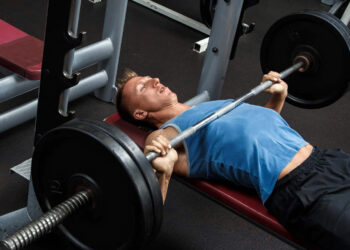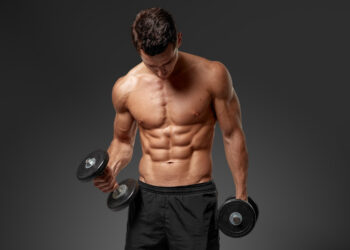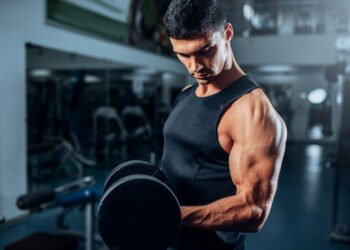Whether you are a wrestler, boxer, judoka, or MMA fighter, you need to have a high level of all-around fitness to perform well. In addition to being skilled in your chosen fighting style, you also need vast reserves of aerobic and anaerobic fitness, power, endurance, and mobility.
And while you don’t necessarily need the brute strength of a powerlifter, being strong will make it easier to control your opponent and make it harder for them to overpower you. For example, strength could be the difference between pinning someone or getting pinned.
As such, fighters should include strength training in their workouts. This comes under the banner of general physical preparedness or GPP for short.
While any strength training is better than none, according to the law of specificity, your workouts should match your fitness goals. That means fighters should avoid training like bodybuilders or powerlifters. Instead, their workouts need to mirror the demands of their sport.
In this article, we reveal some of the best strength training exercises for fighters and provide you with a sample workout to try.
The 10 Best Strength Exercises for Fighters
Build strength for fighting with these TEN awesome exercises!
Level Up Your Fitness: Join our 💪 strong community in Fitness Volt Newsletter. Get daily inspiration, expert-backed workouts, nutrition tips, the latest in strength sports, and the support you need to reach your goals. Subscribe for free!
1. Zercher squat
Named after powerlifter Ed Zercher, Zercher squats are an excellent exercise for fighters. They train your entire body, which is how it works in the octogen or ring. This exercise will help you with your throws and takedowns.
How to do it:
- Place a barbell in a squat rack set to around waist height. Squat down and hook your arms under the barbell so that it rests in the crooks of your elbows. Pad the bar if necessary. Brace your core and pull your shoulders down and back.
- Unrack the bar and adopt a shoulder-width stance.
- Keeping your torso relatively upright, bend your knees, and squat down until your thighs are at least parallel to the floor. Go deeper if you can, but do not round your lower back.
- Stand back up and repeat.
2. Floor press
The bench press is arguably the most popular strength training exercise, but it’s not the best choice for fighters, and it can be hard on your shoulders. The floor press is more joint-friendly and sports-specific. The floor press strengthens the muscles you need to use to push an opponent off you when lying on your back.
How to do it:
- Place a barbell on blocks or in a rack set to about mid-thigh height. Lie on the floor below the bar. Hold the bar with an overhand, slightly wider than shoulder-width grip. Unrack the bar and hold it over your chest.
- Bend your elbows and lower the bar down until your triceps lightly touch the floor.
- Push the bar back up and repeat.
- You can also do this exercise with dumbbells or kettlebells. Make it even more fighter-specific by lifting your hips and doing bridge floor presses.
3. Towel grip chin-up
There is no point in having strong arm and back muscles if your grip is weak. After all, many forms of fighting involve grappling with your opponent. If you can’t keep hold of them, you won’t be able to lift or throw them. This exercise works your back, biceps, and grip all at the same time, making it a very time-efficient exercise for fighters.
How to do it:
- Hang two towels over a pull-up bar, beam, or tree branch. They should be about shoulder-width apart. Hold the towels with a neutral grip, i.e., palms facing inward. Hang with your arms straight and feet clear of the floor.
- Bend your arms and pull yourself up until your shoulders are roughly level with your hands.
- Descend under control and repeat.
4. Barbell rollout
There is a reason that most fighters spend so much time training their core; these muscles are critical for protection from blows to the stomach as well as generating power for kicking, punching, and throwing.
There are literally hundreds of core exercises to choose from, but if you want to build strength for fighting, the barbell rollout is one of the best. Using a barbell means you can use progressively heavier weights as you get stronger.
How to do it:
- Place your loaded barbell on the floor and kneel behind it. Hold the bar with a shoulder-width, overhand grip. Brace your abs.
- Keeping your arms straight, extend your hips and roll the barbell away from you. Lower your chest down toward the floor. Try to fully extend your arms while taking care not to hyperextend your lumbar spine.
- Use your abs and lats to roll the barbell back to your knees and repeat.
- You can also do this exercise from standing, but it’s MUCH more challenging that way.
5. Good morning
The good morning is something of a controversial exercise. Performed incorrectly, it could cause back pain and injury. However, that criticism is true of many exercises! The good morning is a good exercise for fighters because it involves a hip hinge with a long lever to work against. This means it works every muscle from your neck to your hamstrings. Just take care not to round your lower back when you do this exercise.
How to do it:
- Rack and hold a barbell across your upper back. Make sure it is NOT on your neck. Hold the bar with a slightly wider than shoulder-width grip. Pull the bar down onto your back so it won’t move. Brace your core.
- Stand with your feet around hip-width apart, knees slightly bent.
- Push your hips back and hinge forward. Lean as far as you can without rounding your lower back.
- Drive your hips forward and stand up.
- You can also do this exercise with a safety squat bar.
6. Landmine half-kneeling single-arm shoulder press
The landmine is an invaluable tool for fighters. You can use one to train virtually every muscle in your body in a very joint-friendly way. Of all the landmine exercises you can choose from, the half-kneeling single-arm overhead press is one of the best for fighters.
Think of this exercise as a cross between a full overhead press and a chest press. It works your shoulders, chest, triceps, and core, which are your punching muscles. But, because it’s done in the half-kneeling position, you can’t use your legs, making it a total upper body exercise.
Level Up Your Fitness: Join our 💪 strong community in Fitness Volt Newsletter. Get daily inspiration, expert-backed workouts, nutrition tips, the latest in strength sports, and the support you need to reach your goals. Subscribe for free!
How to do it:
- Kneel at the end of your landmine bar with your left leg forward and your right leg back. Both knees should be bent to 90-degrees. Hold the end of the bar at shoulder height in your right hand, with your palm facing inward.
- Brace your core and make sure your torso is perfectly vertical. Do not lean to the side.
- Press the bar up and slightly forward, leaning into the movement.
- Lower your hand back to your shoulder and repeat.
- Rest a moment, swap sides, and repeat.
7. Pendlay row
While it would be easy to focus on your chest, shoulders, and triceps to build punching strength, your back muscles are every bit as important. Your back muscles provide the platform for your punching muscles and also pull your arm back, ready for your next punch. The back (and biceps) are also crucial striking muscles.
There are lots of great back exercises to choose from, including single-arm dumbbell rows and cable rows. Still, the Pendlay or dead-stop row is arguably one of the best.
Pausing between reps gives your grip and back a brief rest so you can use heavier weights. Also, those very same pauses break the eccentric/concentric stretch-shortening cycle, making every rep that much harder.
How to do it:
- Start with your barbell on the floor. Stand with your feet about hip to shoulder-width apart, toes under the bar.
- With your knees slightly bent, hinge forward from the hips and bend over until your upper body is parallel to the floor. Make sure your lower back is slightly arched and not rounded.
- Grab the barbell with an overhand, slightly wider than shoulder-width grip. Tuck your chin in and lengthen your neck; do not lift your head and look forward.
- Brace your core, squeeze your shoulder blades together, and pull the bar up into your abdomen. The bar should touch your stomach. Lead with your elbows, keeping your upper arms tucked in close to your sides. Your upper body should remain stationary throughout. Do not use your legs or lower back to lift the weight. If you can’t keep your upper body still, you are probably using too much weight.
- Under control, lower the barbell back down the floor and allow it to touch down, reset your core, and repeat.
8. Sumo deadlift high-pull
The sumo deadlift high-pull is a full-body exercise to rival the power clean. Power cleans ARE a great exercise, but they’re not that easy to master. SDHPs are much more accessible and every bit as effective. Done with heavy weights, this exercise will build total-body strength and power but done for high reps, this is an excellent conditioning exercise.
How to do it:
- Place your barbell on the floor. Ideally, it should be about mid-shin height, as though you are using full-sized bumper plates.
- Stand with your toes under the bar. Your feet should be about 1.5 shoulder-widths apart, toes turned slightly outward.
- Reach down and hold the bar with an overhand, shoulder-width grip so your arms are inside your legs. Your shoulders should be slightly in front of the bar.
- Brace your core, straighten your arms, pull your shoulders down and back, and adopt a neutral spine, i.e., slightly arched and not rounded. Your hips should be below shoulder height.
- Driving down through your heels and initially keeping your arms straight, explosively extend your legs and lift the bar upward.
- Just as your hips and knees near lockout, shrug your shoulders, pull with your arms, and bring the bar up and under your chin. Keep your elbows up and out.
- Lower the weight back to your hips and then place it back on the floor.
9. Sled push
Weighted sled pushes are a one-part strength and one-part conditioning exercise. As such, they are perfect for fighters. They work your entire body, especially the hip extenders, core, deltoids, and triceps.
While you can do sled pushes with a light weight for long distances to build fitness, they’re far more useful if you use more weight and work over shorter distances. 20-30 seconds per set is best for building strength.
How to do it:
- Load up your sled with plenty of weight. Hold the vertical or horizontal handles as preferred.
- With your arms straight, drop your hips, so they’re just below the height of your hands. Brace your core.
- Moving explosively, extend each leg in turn to drive the sled forward. Keep your arms straight and core braced throughout.
10. Medicine ball rotational punch throw
This exercise is technically a power exercise and not a strength exercise. But, it’s such a good move that we couldn’t resist including it in our list! As the name implies, doing this exercise will increase punching power, and it’s good for your rotational core strength, too.
How to do it:
- Stand side onto a flat, strong wall in something resembling your fighting stance. Hold your medicine ball in your hands. Raise the ball to shoulder height and turn your upper body away from the wall.
- Using your legs, hips, core, shoulder, and arm, turn your upper body and drive the ball out at the wall. Make sure the arm furthest from the wall does most of the work.
- Catch it as it rebounds and repeat for the desired number of reps.
- Switch sides and repeat with the other arm.
Strength Workout for Fighters
While you could just include these exercises in your workouts, you’ll probably get better results if you follow a more structured program. Do these workouts on non-consecutive days, e.g., Monday and Thursday, to allow plenty of time for rest, recovery, and conditioning training.
Make sure you spend a few minutes warming up before hitting the gym. Do some light cardio followed by dynamic mobility and flexibility exercises for the joints you’re about to use. Finish off your warm-up with a couple of sets of the first exercise from the workout you are about to do.
Strength Workout for Fighters # 1
| # | Exercise | Sets | Reps | Recovery |
| 1 | Zercher squat | 4 | 6-8 | 90 seconds |
| 2 | Floor press | 3 | 6-8 | 90 seconds |
| 3 | Good morning | 3 | 8-10 | 60 seconds |
| 4 | Towel chin-up | 3 | AMRAP | 90 seconds |
| 5 | Barbell rollout | 3 | 10-12 | 60 seconds |
| 6 | Finisher: Air bike sprint | 10 | 20 seconds | 40 seconds |
Strength Workout for Fighters # 2
| # | Exercise | Sets | Reps | Recovery |
| 1 | Sumo deadlift high-pull | 4 | 6-8 | 90 seconds |
| 2 | Landmine single-arm shoulder press | 3 | 6-8 | 90 seconds |
| 3 | Sled push | 3 | 10 meters | 60 seconds |
| 4 | Pendlay row | 3 | 8-10 | 60 seconds |
| 5 | Medicine ball rotational punch throw | 3 | 6-8 per side | 60 seconds |
| 6 | Finisher: Rower | 4 | 500 meters | 2 minutes |
Wrapping Up
Not so many decades ago, coaches and trainers believed that lifting weights made a fighter slow. They even had a name for what they thought would happen to fighters who lifted weights – muscle-bound.
While training like a bodybuilder could hurt your performance, strength training will help make you a more formidable fighter, not to mention more resistant to injury.
Strength training for fighting doesn’t have to be complicated. Just look at the muscles and movements you perform most often and choose exercises that replicate them. You’ve got ten great exercises to get you started.
While you’ll still need to work on your fighting skills and conditioning, improving your strength will definitely make you harder to handle in octogen or ring or on the mat.








